At the end of last year, I had the opportunity to travel for more than three months through Southeast Asia. I have already stated my travel plans before, and now the time has come where I want to recap on visiting the Elephant Jungle Sanctuary in Chiang Mai. It was hands down one of the best experiences in my life and I want to share this awesome day I had with You. If You are looking for a great travel experience, then I can only recommend You to book a trip to an Elephant Sanctuary as well. All of the following images have been taken with my FujiX100F.
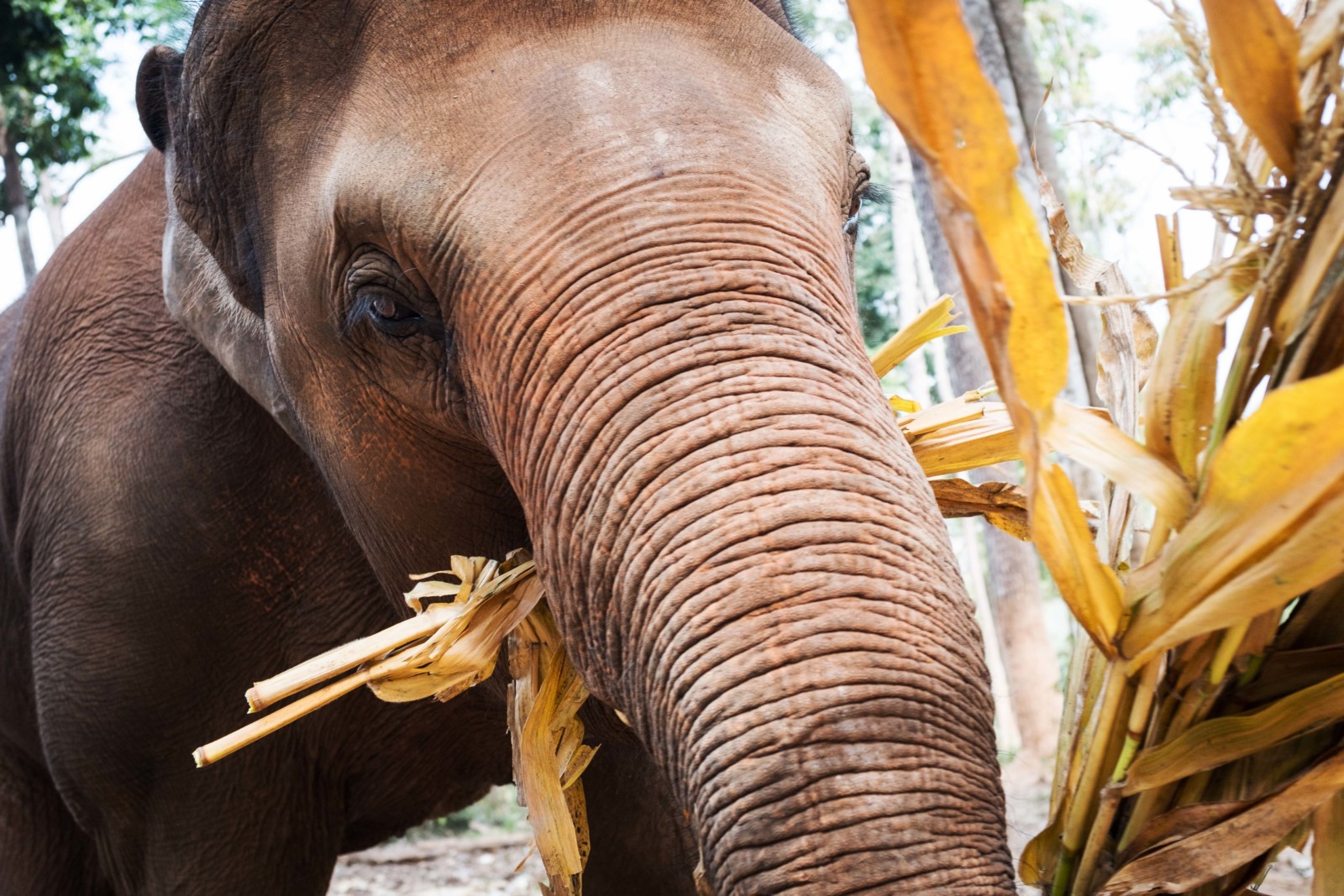
Ethical Traveling
Normally I am not very conscious about the way of traveling and I respect that some cultures and interests are just different. But recently, there is a rise of consciousness when it comes to traveling and more tourists are becoming aware of the drawbacks that traveling can have.
Traveling is a great experience individually, but when it becomes a mass event, there are all kinds of problems that arise. Think about the waste that becomes unbearable for the local waste management, the expulsion of local culture in exchange for more tourism-focused businesses and a general rise in the industry.
What were small scaled family-run businesses become now for maximum profit scaled businesses and together with it, they usually don’t care about the long-term effects, or simply don’t want to realize that mass tourism also has a lot of negative side-effects.
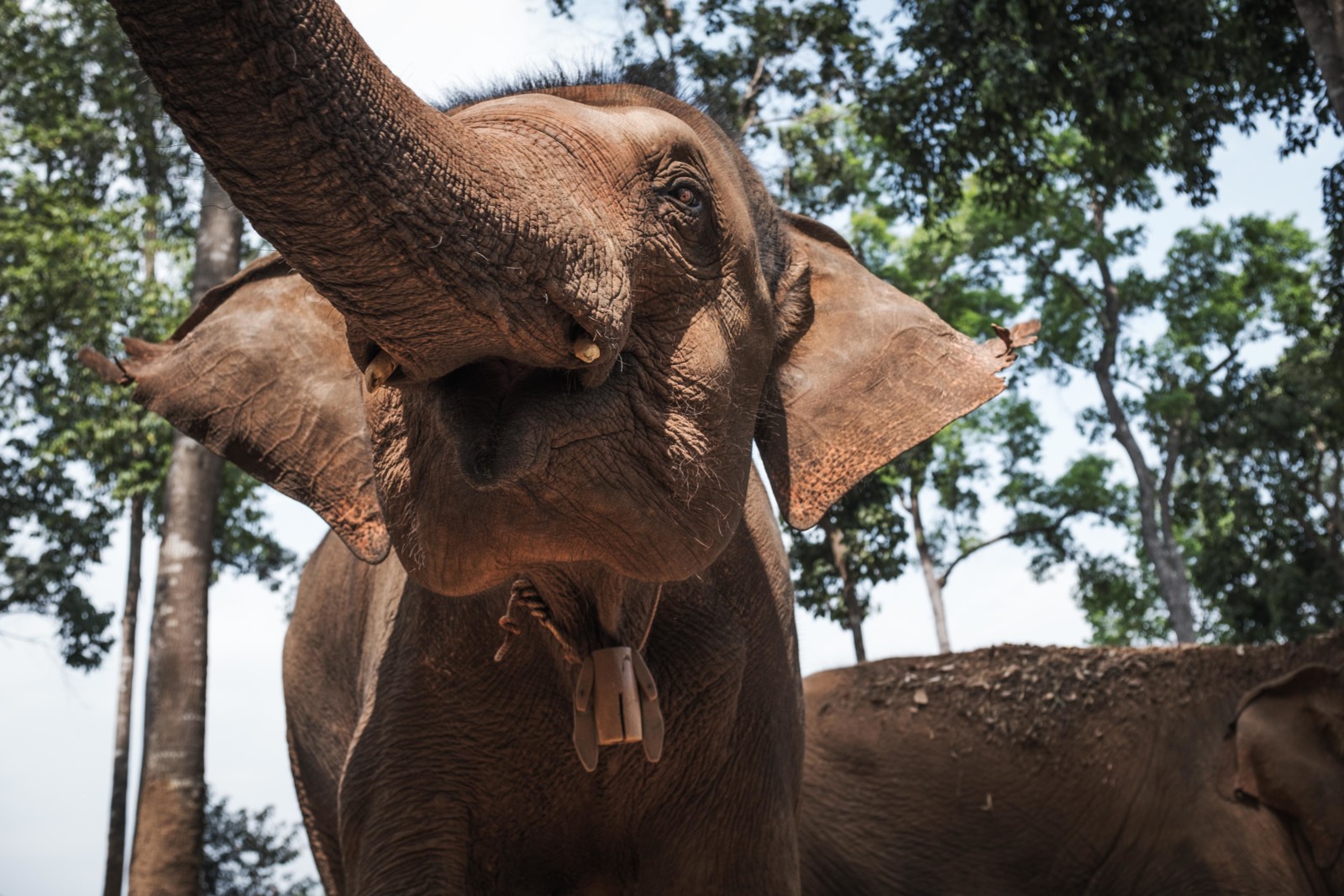
Luckily, there is a rise of awareness for all those problems and more tourists demand ecological friendly trips that are more in line with the local culture.
Unfortunately, there is the prejudice that sustainable tourism is not that exciting and uninteresting in comparison to conventional tourism. From my own experience, I can only argue that it was one of the best trips I could have ever imagined.
It was not only a lot of fun but also educational and You get the opportunity to support a good cause.
Conventional Elephant Tourism
How does “conventional” elephant tourism look like and why is it so bad?
There are a lot of pictures floating around the Internet where You can see the tourists riding the elephants or seeing them perform some tricks. Now You could think that the elephants are big and strong enough to easily carry humans. While this is true, it is absolutely unnatural for them to do so.
To get them to perform tricks or carry tourists on their backs, they are mistreated from very young age. Often they are separated from their mom way too young. For animals that form very strong social bonds, this separation has a serious impact on their well-being.
In addition, they are physically abused to follow the orders of their trainers. As if this wasn’t already daunting, they are also often kept in very bad spaces. Sometimes even tied or restraint for the little amount of time, where they aren’t used to entertain tourists.
There have been many studies out there that show, that the so-called “harmless” elephant riding has severe negative health impacts and therefore shouldn’t be supported. If You want to enjoy the elephants, please refrain from those businesses and rather search for elephant sanctuaries that are not run for a profit, but for the well-being of the animals.

What is an Elephant Sanctuary
Of course, the detailed models and structure of every elephant sanctuary can differ slightly and I can only speak for the elephant jungle sanctuary that I visited in Chiang Mai, but if You do Your research, You will find that the sanctuaries are often founded on the same principles.
First of all, the elephant sanctuaries aren’t run for profit. Yes, they generate income for example with the trips they offer to visit the elephants, but the money is used to support the elephants directly.
In fact, at the sanctuary where I was used most of the money to feed the elephants. The amount of food they need seems sheer endlessly and it is true that they practically eat the whole day when they are not sleeping. Some of the food is produced on the nearby field, but that is not enough and a lot has to be bought on the markets.
The Elephant Sanctuary where I went to was directly linked to an elephant hospital. All of the workers are volunteers that don’t receive a huge salary to take care of the elephants. Yet around 30% of the money is used for medical bills and the treatment. The remaining money is spent for the administrative purpose.

Often times these sanctuaries are part of a charitable organization that is also linked to neighboring elephant hospitals that all are non-profit and rely on the tourism income and additional donations or support by the public.
The sanctuaries are basically big free roaming areas where the elephants can do whatever they want. This isn’t like a zoo where they are bound to a very small compound and You as a visitor can stand outside and see them. In a sanctuary, You are basically entering their living room and if the elephants aren’t in the mood to welcome You, they can simply leave.
Now the good news is, that this is very unlikely. Every elephant has a personal caretaker and since the elephants are always hunting for food they are essentially “bribed” by food to follow the caretakers. In addition to that, the elephants seem to enjoy the interaction with the visitors and You can witness how playful they are.
Nonetheless, keep in mind that the elephants aren’t forced to anything. Some elephants might leave the group earlier and not show up to the afternoon mudbath, while others are enjoying the company of the visitors for the whole day.
Elephants in Thailand
Why is there even a need for elephant sanctuaries in Thailand?
In Thailand, elephants are a very big part of the culture and I want to shed some light on the background of the elephants there.
Basically, elephants have been trained and used for manual labor and as war machines for thousands of years. Where farmers in the west relied on oxen or horses, in Thailand they used elephants instead. Elephants were also needed to transport logs or other heavy goods, before the industrialization.
While elephants surely weren’t treated well at that time and had to endure a lot of abuse, they were needed for the people to survive. In the early 1900’s there is said that around 100.000 domesticated or captivated elephants lived in Thailand.
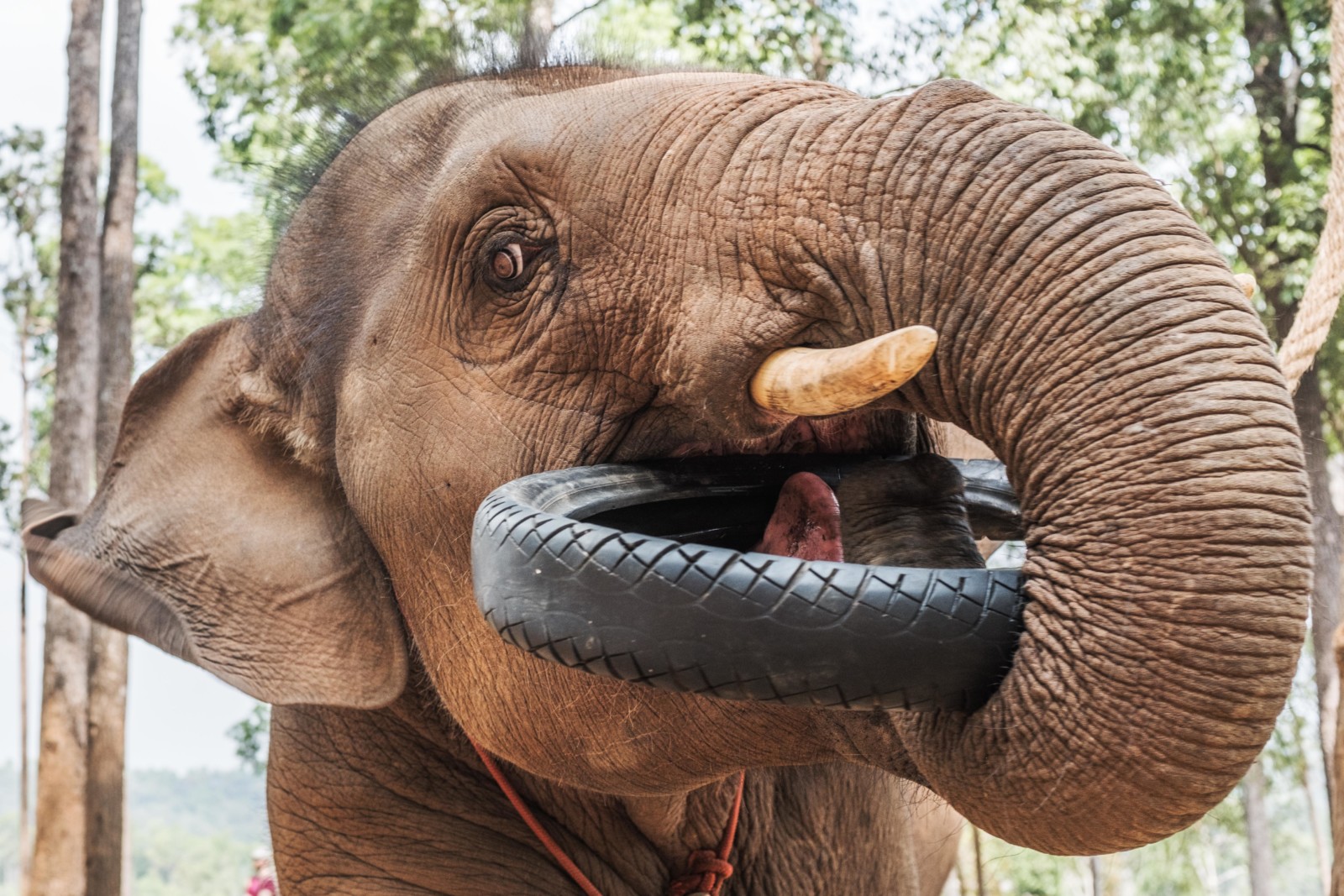
This number changed dramatically. In 2007 there have been said that only a little more than 3.000 domesticated elephants and around 1.000 wild elephants are left in Thailand. The cause for this is, that elephants have been replaced by machinery and aren’t needed anymore for manual labor.
The technological advancement allowed the farmers to use motorized machinery and just like oxen have vanished as workforce, elephants weren’t needed anymore as well. During the modernization, more and more elephants were left “jobless” and compared to oxen or horses they are very costly in upkeep and maintenance.
As tourism grew, business owners began to see the potential in these elephants to make money with them and the purpose of the elephants shifted from being a workforce, to entertain tourists.
Just as a disclaimer, the elephants weren’t particularly treated badly in the Thai culture. Although the previous paragraphs might have sounded very negative, the elephant is a sacred animal in the Buddhist culture and is very highly regarded.
The need for elephant sanctuaries shows, that they rather try to find appropriate places for elephants to lead their life, rather than putting them down when there is no “need” for them anymore.

The Elephant Jungle Sanctuary in Chiang Mai
Now I want to describe my actual day at the Elephant Jungle Sanctuary in Chiang Mai.
There are a lot of different elephant sanctuaries that You can go to and offer a great service. I visited the Elephant Jungle Paradise Park, which has been recommended by my Airbnb host. This sanctuary has a 4.9 Star rating out of over 500 reviews on Facebook, which should tell You that they really offer a great experience.
I was living a little outside of Chiang Mai and the day began very early when a Tuk-Tuk driver drove me to the city of Chiang Mai. There I was already greeted by the driver of the sanctuary which would lead us to the paradise park.
All the sanctuaries are located in the mountains and driving there takes about two hours from Chiang Mai. On the way there, we also had the opportunity to visit a local market, which was a nice change since a lot of places in Chiang Mai are already very adapted to the tourism. The drive to the elephant sanctuary was an experience itself. A lot of the roads were under maintenance or construction work and driving there was already very exciting.
As we arrived, we changed our clothes and were provided traditional tops that should calm the elephants. That morning, I learned that elephants have terrible eye-sight and the purpose of the clothing should be to make them more familiar with new visitors.
After the introduction and the Do’s & Dont’s, we were led to the first feeding ground. There the elephants already patiently waited behind the small log railing. Every elephant has its own caretaker and the caretaker also provide the extra food to the elephants. While the elephants are not forced to wait behind the railings, it is their usual daily routine which is rewarded with food.
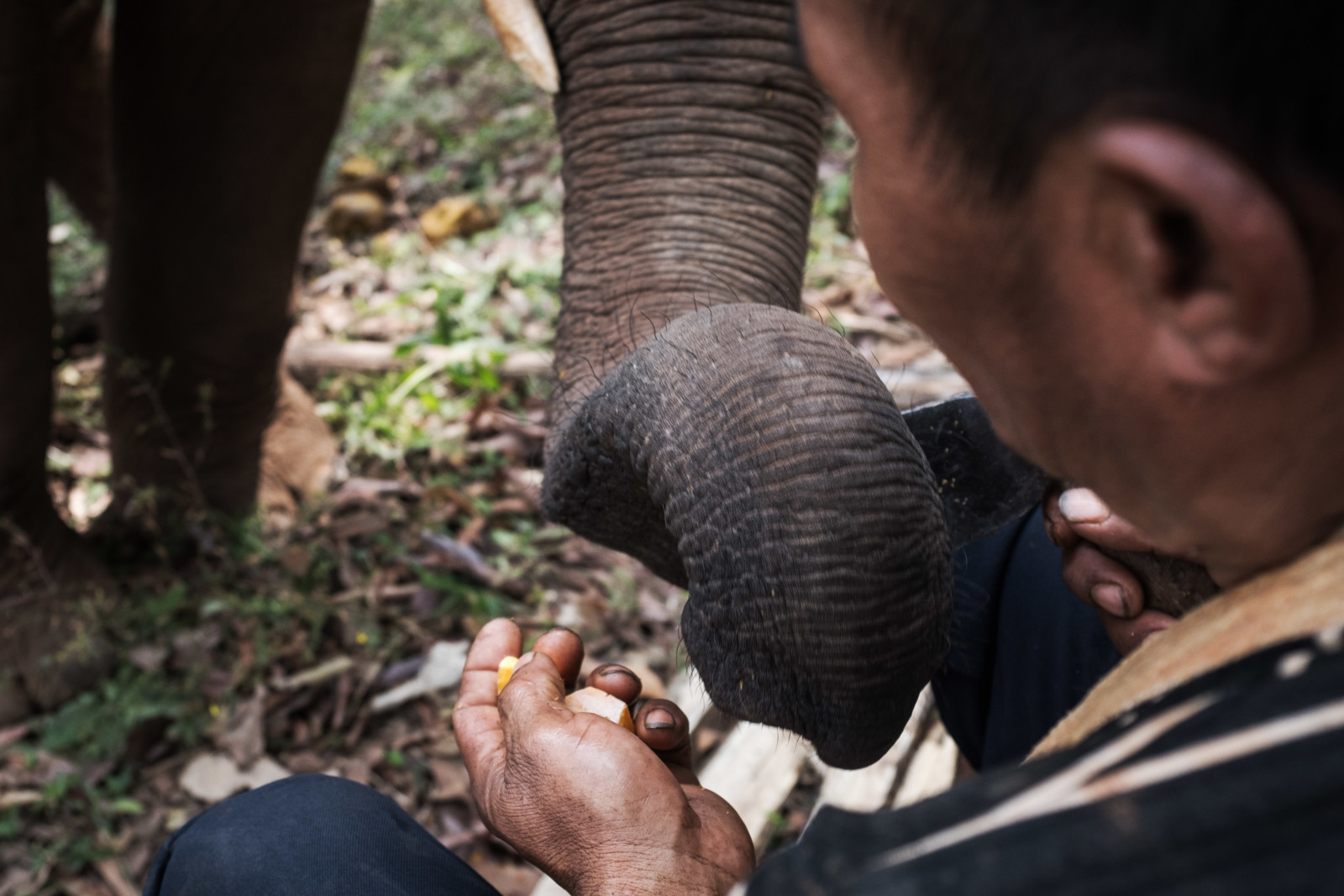
Not long after, the elephants left the railings and roamed freely among us visitors. There we could feed them very closely and take pictures. Keep in mind though that these are still wild and powerful animals. Although they are very gentle, they can still hurt by accident.
This is especially for the newborn which was also in the middle of the action. Only a few months old, its idea of playing with us was a little too rough and it wanted to prove that it is the stronger of us too with playful headbutts.
The elephant group also split at some point and single elephants were left into the jungle, while others were still eager to be fed or played with a tire.
Following the first feeding session, our group was lead to the waterfall and base camp of the elephant sanctuary. There we had a fantastic lunch consisting of local meals and fruits.
After finishing our own lunch, we prepared some snacks for the elephants that we could feed them later. What was great was that everyone was involved in preparing the food and our guide also explained what the elephants eat. In general, the tour was not only really entertaining but also educational at times without being boring.
If You already searched for a trip to an elephant jungle sanctuary You have probably seen the mud baths together with the elephants. I have to admit that I don’t have taken any pictures personally because I didn’t want to damage my equipment, but the Elephant Jungle Paradise Park has its own photographer. They publish their pictures on Facebook and they are really fast in keeping all their tours up-to-date with usually more than 50 pictures posted of each tour. So You don’t need to be afraid that You have to take photographs with Your smartphone or camera if You want to You can simply enjoy the stay there, pose together with the elephants and later have a look at the pictures on the Facebook gallery.
Anyway, the mud bath was next and we changed to our bathing clothes. Coming closer to the mud, two elephants were already enjoying the bath and playing in the dirt. For them, the mud is important to cool down and to be protected from the sun. Although there isn’t much direct light in the jungle, it is still hot and for elephants, it can be difficult to regulate their body temperature. Therefore the mudbath is also one of the highlights for them.
To help the elephants out, we got in the mud and essentially bathed there too. We rubbed the mud on the elephants and feeling the thick skin was awesome and much different than I had anticipated. The elephants were thankful and “showered” us in mud too. Yes, they were basically inhaling the muddy water and spraying it at us with their trunks. Seeing the elephants having fun and being close to them is so much better than seeing them lying down lazily in a zoo.
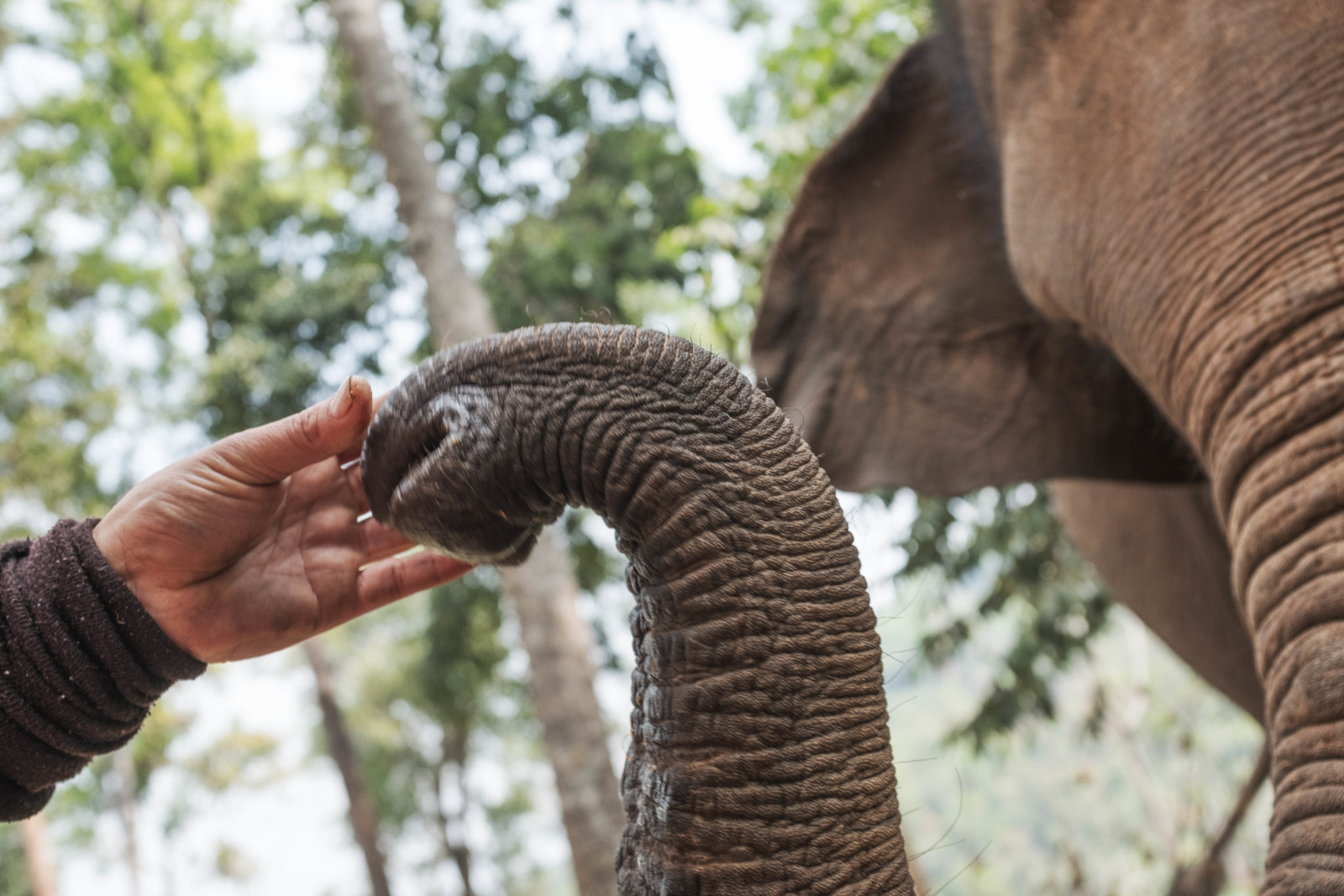
Now we were all dirty from the mud, but luckily there is a natural shower in the form of the waterfall. So we got back to our camp and cleaned ourselves and soon after, the elephants were joining us too. In the small river, we splashed buckets full of water at them until they were cleaned as well.
This pretty much concluded the whole day which lasted from the morning till the evening. It was everything I looked forward too and much more. I am no expert, but to me, the elephants were genuinely happy, didn’t show any aggressive behavior and were very well kept.
In the morning, I recall that there was about a handful of elephants and for the evening apparently only two were eager to go to the mud bath. At the very morning, there was also the birth of another elephant calve, which were kept safe and away from the visitor’s area.
All of the people working there were really interested in the well-being of the elephants. The caretakers were providing food but didn’t force the elephants to perform tricks or other unnatural behavior.
To conclude my trip, I can only recommend to visit an elephant jungle sanctuary Yourself. Have a look at Tripadvisor or Facebook before booking one and You will have gained some good insight into the work of the sanctuary. In general, look out for sanctuaries that explicitly state that the elephants are not for riding, as this will be a good indicator that the place does care for the elephants and not the tourists.
Elephant Jungle Sanctuary Price
Now that You may be interested in visiting an elephant jungle sanctuary, there is also the question how much such a trip costs and what is already included in the price. Of course, I can only speak for the sanctuary that I visited again, but it shouldn’t differ too much.
My trip was organized by my Airbnb host and did cost around $50 overall. This included the transfer from the outskirts of Chiang Mai to the city with a Tuk-Tuk and then the transportation to the actual elephant sanctuary in the mountainside. We started early at 7 am and the whole trip lasted until the evening and I arrived around 6 pm at home when it was already getting dark again.
In addition to the transportation, the sanctuary provided an amazing lunch buffet with fresh fruit and local meals. The food was plentiful and during the lunchtime, it was also easier to get to know the other guests better. In a group there around 8 people, but depending on the booking there can also be less.
Mostly, there are two options. I booked a full day with the elephants which lasted from the morning to evening, but You can also book half a day. Since the drive is already long, I would definitely book the full day there.
Included is also the photographer who takes pictures the whole day. You can ask them to take some pictures while You are posing next to an elephant and the photographs are uploaded very quickly onto facebook where You can download them.
As already before, the money didn’t really feel expensive since almost all of it goes directly to the elephants again. Therefore it is more like a donation for me and it is great to spend that money to support the sanctuary directly.
It is great to see that the tourism industry is changing and that there are more trips catered toward tourists that want to experience the real life of the elephants instead of some show they have to perform for tourists.
The trip was truly an experience for life and I can’t state enough how great of a trip it was. Please stay away from conventional tourism businesses where elephants are used for riding or show tricks and support these animal-friendly places.





















